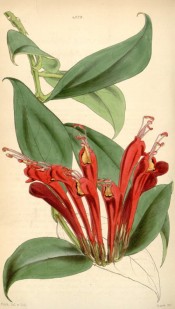Aeschynanthus longiflorus (Blume) DC.
Frost-tender, robust, trailing, evergreen, epiphytic perennial with ovate leaves, to 16cm, and terminal clusters of dark red flowers, with orange-red lobes and a distinctive black-margined blotch, in summer. To 80cm. [RHSD, Don].
Horticultural & Botanical History
It was collected by Thomas Lobb and introduced to Britain in 1845, first flowering in England at the nursery of Veitch and Sons in Exeter in 1847. According to The Gardeners’ Chronicle it was distinguished from others by its long trumpet-shaped flowers of a remarkably rich shaded crimson tint. [Gard. Chron. 1848]. ‘When describing the Aeschynanthus speciosus (Bot. Mag. t. 4320), we gave our readers reason to expect that another species would soon be represented, which would vie in beauty with that eminently handsome plant; and we now keep our pledge. Closely as the two species are allied, they are unquestionably distinct; and the differences are equally apparent in the dried native specimens as in the living ones. Much of the beauty of Ae. speciosus is due to the varied colour (red and yellow) of the corolla; in the present, to the rich uniform puce of the entire flower.’ [BM t.4328/1847]. FS pl.VI 11e Liv./1847.
History at Camden Park
Listed in the 1850 and 1857 catalogues [T.31/1850].
Notes
Aeschynanthus oblongifolia D.Don (1837) = Chirita acuminata R.Br., a shrub with a thick, tetragonal stem, ovate, hairy leaves, and whitish red flowers tinged with yellow. This is an outside possibility for Macarthur’s plant.
Published Aug 27, 2009 - 05:13 PM | Last updated Jul 21, 2010 - 03:26 PM
| Family | Gesneriaceae |
|---|---|
| Category | |
| Region of origin | South East Asia |
| Synonyms | |
| Common Name | Lipstick plant |
| Name in the Camden Park Record | Aeschynanthus longifolius |
| Confidence level | medium |
